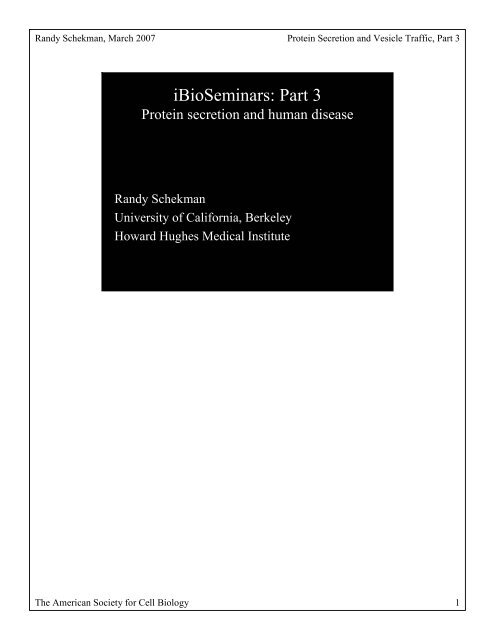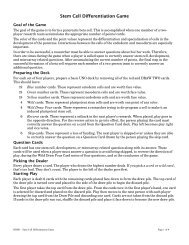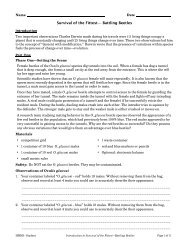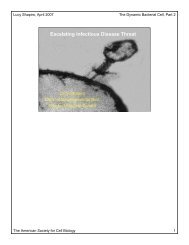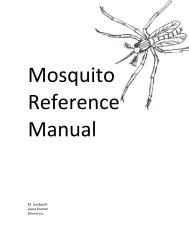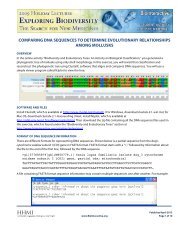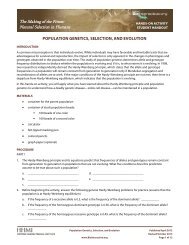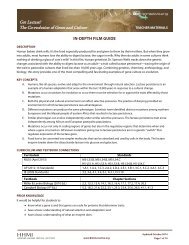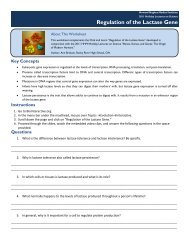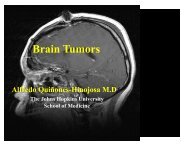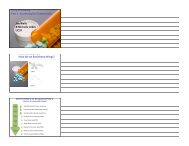Protein Secretion and Vesicle Traffic - Howard Hughes Medical ...
Protein Secretion and Vesicle Traffic - Howard Hughes Medical ...
Protein Secretion and Vesicle Traffic - Howard Hughes Medical ...
You also want an ePaper? Increase the reach of your titles
YUMPU automatically turns print PDFs into web optimized ePapers that Google loves.
R<strong>and</strong>y Schekman, March 2007 <strong>Protein</strong> <strong>Secretion</strong> <strong>and</strong> <strong>Vesicle</strong> <strong>Traffic</strong>, Part 3iBioSeminars: Part 3<strong>Protein</strong> secretion <strong>and</strong> human diseaseR<strong>and</strong>y SchekmanUniversity of California, Berkeley<strong>Howard</strong> <strong>Hughes</strong> <strong>Medical</strong> InstituteThe American Society for Cell Biology 1
R<strong>and</strong>y Schekman, March 2007 <strong>Protein</strong> <strong>Secretion</strong> <strong>and</strong> <strong>Vesicle</strong> <strong>Traffic</strong>, Part 3Mutations in a Sar1 GTPase of COPIIvesicles are associated with lipidabsorption disordersBethan Jones, Emma L. Jones, Stephanie A. Bonney, Hetal N. Patel, Arjen R.Mensenkamp, Sophie Eichenbaum-Voline, Mats Rudling, Urban Myrdal, GraziaAnnesi, S<strong>and</strong>hia Naik, Nigel Meadows, Aldo Quattrone, Suhail A. Islam, Rossitza P.Naoumova, Bo Angelin, Recaredo Infante, Emile Levy, Claude C. Roy, Paul S.Freemont, James Scott, & Carol C. ShouldersŹDietary fat is an important source of nutrition. Here we identify eightmutations in SARA2 that are associated with three severe disorders of fatmalabsorption. The Sar1 family of proteins initiates the intracellulartransport of proteins in COPII (coat protein)-coated vesicles. Our datasuggest that chylomicrons, which vastly exceed the size of typical COPIIvesicles, are selectively recruited by the COPII machinery for transportthrough the secretory pathways of the cell.The American Society for Cell Biology 2
R<strong>and</strong>y Schekman, March 2007 <strong>Protein</strong> <strong>Secretion</strong> <strong>and</strong> <strong>Vesicle</strong> <strong>Traffic</strong>, Part 3The American Society for Cell Biology 3
R<strong>and</strong>y Schekman, March 2007 <strong>Protein</strong> <strong>Secretion</strong> <strong>and</strong> <strong>Vesicle</strong> <strong>Traffic</strong>, Part 3The American Society for Cell Biology 4
R<strong>and</strong>y Schekman, March 2007 <strong>Protein</strong> <strong>Secretion</strong> <strong>and</strong> <strong>Vesicle</strong> <strong>Traffic</strong>, Part 3CLSD mutation: Alignmentwith yeast sequence <strong>and</strong> structureThe American Society for Cell Biology 5
R<strong>and</strong>y Schekman, March 2007 <strong>Protein</strong> <strong>Secretion</strong> <strong>and</strong> <strong>Vesicle</strong> <strong>Traffic</strong>, Part 3The American Society for Cell Biology 6
R<strong>and</strong>y Schekman, March 2007 <strong>Protein</strong> <strong>Secretion</strong> <strong>and</strong> <strong>Vesicle</strong> <strong>Traffic</strong>, Part 3The American Society for Cell Biology 7
R<strong>and</strong>y Schekman, March 2007 <strong>Protein</strong> <strong>Secretion</strong> <strong>and</strong> <strong>Vesicle</strong> <strong>Traffic</strong>, Part 3Membrane surface view of Sec31 inproximity to the F382 residue of SEC23ALateral viewThe American Society for Cell Biology 8
R<strong>and</strong>y Schekman, March 2007 <strong>Protein</strong> <strong>Secretion</strong> <strong>and</strong> <strong>Vesicle</strong> <strong>Traffic</strong>, Part 3ER exit sites in mut. 23A, #2The American Society for Cell Biology 9
R<strong>and</strong>y Schekman, March 2007 <strong>Protein</strong> <strong>Secretion</strong> <strong>and</strong> <strong>Vesicle</strong> <strong>Traffic</strong>, Part 3EndocytosisThe American Society for Cell Biology 10
R<strong>and</strong>y Schekman, March 2007 <strong>Protein</strong> <strong>Secretion</strong> <strong>and</strong> <strong>Vesicle</strong> <strong>Traffic</strong>, Part 3Amphipathic helices promote membrane curvatureThe American Society for Cell Biology 11
R<strong>and</strong>y Schekman, March 2007 <strong>Protein</strong> <strong>Secretion</strong> <strong>and</strong> <strong>Vesicle</strong> <strong>Traffic</strong>, Part 3Membrane curvature generated by asymmetricexpansion of outer leafletThe American Society for Cell Biology 12
R<strong>and</strong>y Schekman, March 2007 <strong>Protein</strong> <strong>Secretion</strong> <strong>and</strong> <strong>Vesicle</strong> <strong>Traffic</strong>, Part 3Sar1p deforms membranes in anucleotide-dependent mannerThe American Society for Cell Biology 13
R<strong>and</strong>y Schekman, March 2007 <strong>Protein</strong> <strong>Secretion</strong> <strong>and</strong> <strong>Vesicle</strong> <strong>Traffic</strong>, Part 3Revised model of how COPII - Sar1pinitiates buddingThe American Society for Cell Biology 14
R<strong>and</strong>y Schekman, March 2007 <strong>Protein</strong> <strong>Secretion</strong> <strong>and</strong> <strong>Vesicle</strong> <strong>Traffic</strong>, Part 3The Secretory PathwayCell SurfaceCOPIEarlyEndosomeClathrin, AP1LateEndosomeERCOPIIGolgiThe American Society for Cell Biology 15


